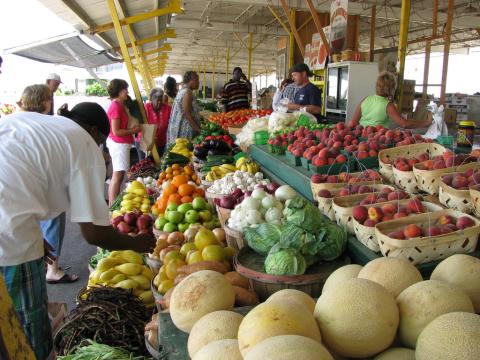
Have you seen a farmers’ market that has opened near you? If so, you’re not alone. The number of farmers’ markets doubled between 2009 and 2014, with locally marketed food sales reaching $6.1 billion as of 2012. Farmers and public markets all seek to improve food access while promoting the local economy and building a greater sense of community.
While sometimes local food may just seem to be the latest “trend,” from the standpoint of community wealth building, developing local food systems that meet the needs of low-income communities and communities of color are critically important. One challenge facing our food system is an aging workforce, with farmers older than 65 years old three times as common as farmers under 35 years old. An even greater challenge for community wealth building advocates is that even as the United States helps feed the world, an estimated one tenth of the U.S. population lacks food security. With communities of color, these numbers are even higher: One in five Latino households and one in four African American households don’t regularly get enough healthy food to eat. There are ways to solve both of these problems together by engaging young people of color in their local food system. (Right: Farmers' Market, Jackson, Mississippi, photo by Natalie Maynor)
As Natasha Bowens writes in The Color of Food, “We have farmers markets opening in predominantly ethnic neighborhoods without farmers of color, bilingual staff or culturally relevant foods—which does not help increase food access in these neighborhoods.” While local food may not address all needs, community-specific efforts can make a significant difference. A few examples of community groups that are tackling this challenge are the Hmong American Farmers Association (HAFA) and Latino Economic Development Center (LEDC), both based in Minnesota, and Thunder Valley Community Development Corporation (Thunder Valley CDC) on the Pine Ridge reservation (Oglala Lakota Nation territory) in southwestern South Dakota. (Note: The Democracy Collaborative has worked directly with Thunder Valley CDC for the past three year; for more information, see our Learning/Action Lab for Community Wealth Building website).

In some cases, federal programs can support these community-based efforts to address racialized food insecurity. Two USDA programs— the Beginning Farmer and Rancher Development Program (BFRDP) and the Community Food Projects (CFP) program—are particularly important. Both operate out of the National Institute of Food and Agriculture (NIFA). (Left: A HAFA member holds a sweet potato cutting after a harvest on their Minnesota farm. Photo by Mike Hazard)
The current Beginning Farmer & Rancher program was launched in 2008 to mentor, recruit, and provide training and education programs for the next generation of farmers/ranchers/forest managers. The grants prioritize programs that emphasize financial management and marketing education and training. This program is being utilized by communities of color.
HAFA and LEDC jointly applied for, and received, BFRDP grants in 2012 and 2015 to implement culturally appropriate training and farming practices for Hmong and Latino farmers in Minnesota. Over half of all producers at farmers’ markets in the Twin Cities are Hmong farmers. HAFA started in 2011 as a food hub to network, advocate, and educate Hmong farmers through managing a 155-arce farm, pooling produce and selling it. (Food hubs receive food from small and mid-size farms, adds value, and distributes it). LEDC provides technical and leadership skills for the economic progress of the Latino community. A few LEDC successes are the creation of the Cooperative Mercado Central and Midtown Global Market. The BFRDP grants support both Hmong and Latino farmers to earn livable incomes through offering business, marketing, and crop planning, micro-loans for new products, and an increased ability to sell to schools, institutions and restaurants as well as farmers’ markets.
The Community Food Projects Competitive Grant Program (CFP) also promotes long-term community-based solutions to food insecurity in low-income communities. As well as serving low-income communities, the majority of CFP projects serve African American, Latino, and multi-racial households.
Thunder Valley CDC received a CFP grant in 2015 to start a demonstration farm on their Regenerative Community property on Pine Ridge. With 95 percent of food coming from off the reservation, the goals of the project are to strengthen sovereign access to nutritious and culturally appropriate food, indigenous to the region, beginning with the creation of a community garden and greenhouse, educational programs for youth and community members, financial and distribution assistance to farmers, and the possible creation of employee-owned businesses and grocery stores increasing employment opportunities for Lakota people. Thunder Valley CDC hosts summer farmers’ markets to connect with producers and is evaluating the feasibility of grocery stores. (Below: As part of Thunder Valley CDC's Food Sovereignty Initiative, Linda Black Elk (Catawaba) led a Medicinal Plant Walk, wherein participants foraged for native medicinal and edible plants on the lands of the Oglala Lakota Nation to incorporate into cooking and nutrition classes).

Increasingly, community groups—such as HAFA, LEDC and Thunder Valley CDC—are taking action to confront racialized food insecurity. While USDA and farmers’ markets play a role in increasing healthy food access, there remains, of course, much to do. As the 2014 Building the Case for Racial Equity in the Food System report by the Center for Social Inclusion highlights, such strategies may include explicit efforts to link rural to urban communities, raise wages in the food industry and/or alter long-standing policies that have created barriers to land ownership for people of color and agricultural workers. Other public policies can also be challenged: for example, public procurement policies can be changed to create more business opportunities for minority-owned businesses, while public subsidies for corporations promoting unhealthy food products can be curtailed. With the passage of better policies more intentional steps need to be taken to link communities of color to the increased economic opportunities and build capacity so they can continue designing secure food systems. The work of HAFA, LEDC, and Thunder Valley CDC, among others, illustrate the potential for culturally resonant, healthy food strategies to generate jobs and improve health in communities of color, while building community wealth.